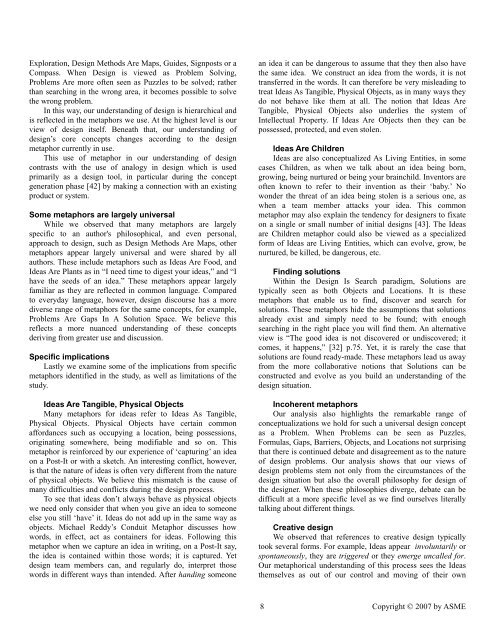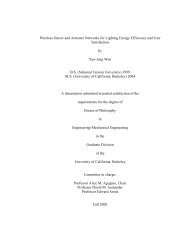Metaphors in Conceptual Design - Berkeley Expert Systems ...
Metaphors in Conceptual Design - Berkeley Expert Systems ...
Metaphors in Conceptual Design - Berkeley Expert Systems ...
Create successful ePaper yourself
Turn your PDF publications into a flip-book with our unique Google optimized e-Paper software.
Exploration, <strong>Design</strong> Methods Are Maps, Guides, Signposts or aCompass. When <strong>Design</strong> is viewed as Problem Solv<strong>in</strong>g,Problems Are more often seen as Puzzles to be solved; ratherthan search<strong>in</strong>g <strong>in</strong> the wrong area, it becomes possible to solvethe wrong problem.In this way, our understand<strong>in</strong>g of design is hierarchical andis reflected <strong>in</strong> the metaphors we use. At the highest level is ourview of design itself. Beneath that, our understand<strong>in</strong>g ofdesign’s core concepts changes accord<strong>in</strong>g to the designmetaphor currently <strong>in</strong> use.This use of metaphor <strong>in</strong> our understand<strong>in</strong>g of designcontrasts with the use of analogy <strong>in</strong> design which is usedprimarily as a design tool, <strong>in</strong> particular dur<strong>in</strong>g the conceptgeneration phase [42] by mak<strong>in</strong>g a connection with an exist<strong>in</strong>gproduct or system.Some metaphors are largely universalWhile we observed that many metaphors are largelyspecific to an author's philosophical, and even personal,approach to design, such as <strong>Design</strong> Methods Are Maps, othermetaphors appear largely universal and were shared by allauthors. These <strong>in</strong>clude metaphors such as Ideas Are Food, andIdeas Are Plants as <strong>in</strong> “I need time to digest your ideas,” and “Ihave the seeds of an idea.” These metaphors appear largelyfamiliar as they are reflected <strong>in</strong> common language. Comparedto everyday language, however, design discourse has a morediverse range of metaphors for the same concepts, for example,Problems Are Gaps In A Solution Space. We believe thisreflects a more nuanced understand<strong>in</strong>g of these conceptsderiv<strong>in</strong>g from greater use and discussion.Specific implicationsLastly we exam<strong>in</strong>e some of the implications from specificmetaphors identified <strong>in</strong> the study, as well as limitations of thestudy.Ideas Are Tangible, Physical ObjectsMany metaphors for ideas refer to Ideas As Tangible,Physical Objects. Physical Objects have certa<strong>in</strong> commonaffordances such as occupy<strong>in</strong>g a location, be<strong>in</strong>g possessions,orig<strong>in</strong>at<strong>in</strong>g somewhere, be<strong>in</strong>g modifiable and so on. Thismetaphor is re<strong>in</strong>forced by our experience of ‘captur<strong>in</strong>g’ an ideaon a Post-It or with a sketch. An <strong>in</strong>terest<strong>in</strong>g conflict, however,is that the nature of ideas is often very different from the natureof physical objects. We believe this mismatch is the cause ofmany difficulties and conflicts dur<strong>in</strong>g the design process.To see that ideas don’t always behave as physical objectswe need only consider that when you give an idea to someoneelse you still ‘have’ it. Ideas do not add up <strong>in</strong> the same way asobjects. Michael Reddy’s Conduit Metaphor discusses howwords, <strong>in</strong> effect, act as conta<strong>in</strong>ers for ideas. Follow<strong>in</strong>g thismetaphor when we capture an idea <strong>in</strong> writ<strong>in</strong>g, on a Post-It say,the idea is conta<strong>in</strong>ed with<strong>in</strong> those words; it is captured. Yetdesign team members can, and regularly do, <strong>in</strong>terpret thosewords <strong>in</strong> different ways than <strong>in</strong>tended. After hand<strong>in</strong>g someonean idea it can be dangerous to assume that they then also havethe same idea. We construct an idea from the words, it is nottransferred <strong>in</strong> the words. It can therefore be very mislead<strong>in</strong>g totreat Ideas As Tangible, Physical Objects, as <strong>in</strong> many ways theydo not behave like them at all. The notion that Ideas AreTangible, Physical Objects also underlies the system ofIntellectual Property. If Ideas Are Objects then they can bepossessed, protected, and even stolen.Ideas Are ChildrenIdeas are also conceptualized As Liv<strong>in</strong>g Entities, <strong>in</strong> somecases Children, as when we talk about an idea be<strong>in</strong>g born,grow<strong>in</strong>g, be<strong>in</strong>g nurtured or be<strong>in</strong>g your bra<strong>in</strong>child. Inventors areoften known to refer to their <strong>in</strong>vention as their ‘baby.’ Nowonder the threat of an idea be<strong>in</strong>g stolen is a serious one, aswhen a team member attacks your idea. This commonmetaphor may also expla<strong>in</strong> the tendency for designers to fixateon a s<strong>in</strong>gle or small number of <strong>in</strong>itial designs [43]. The Ideasare Children metaphor could also be viewed as a specializedform of Ideas are Liv<strong>in</strong>g Entities, which can evolve, grow, benurtured, be killed, be dangerous, etc.F<strong>in</strong>d<strong>in</strong>g solutionsWith<strong>in</strong> the <strong>Design</strong> Is Search paradigm, Solutions aretypically seen as both Objects and Locations. It is thesemetaphors that enable us to f<strong>in</strong>d, discover and search forsolutions. These metaphors hide the assumptions that solutionsalready exist and simply need to be found; with enoughsearch<strong>in</strong>g <strong>in</strong> the right place you will f<strong>in</strong>d them. An alternativeview is “The good idea is not discovered or undiscovered; itcomes, it happens,” [32] p.75. Yet, it is rarely the case thatsolutions are found ready-made. These metaphors lead us awayfrom the more collaborative notions that Solutions can beconstructed and evolve as you build an understand<strong>in</strong>g of thedesign situation.Incoherent metaphorsOur analysis also highlights the remarkable range ofconceptualizations we hold for such a universal design conceptas a Problem. When Problems can be seen as Puzzles,Formulas, Gaps, Barriers, Objects, and Locations not surpris<strong>in</strong>gthat there is cont<strong>in</strong>ued debate and disagreement as to the natureof design problems. Our analysis shows that our views ofdesign problems stem not only from the circumstances of thedesign situation but also the overall philosophy for design ofthe designer. When these philosophies diverge, debate can bedifficult at a more specific level as we f<strong>in</strong>d ourselves literallytalk<strong>in</strong>g about different th<strong>in</strong>gs.Creative designWe observed that references to creative design typicallytook several forms. For example, Ideas appear <strong>in</strong>voluntarily orspontaneously, they are triggered or they emerge uncalled for.Our metaphorical understand<strong>in</strong>g of this process sees the Ideasthemselves as out of our control and mov<strong>in</strong>g of their own8 Copyright © 2007 by ASME
















